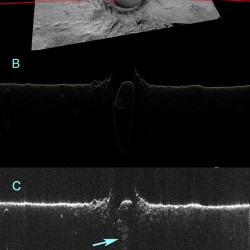Cut the Clutter
May 9, 2010

Interpreting what’s below the surface of Mars is no easy task. There are many potential sources of noise in radar data received by the Shallow Subsurface Radar instrument onboard the Mars Reconnaissance Orbiter. The prime troublemaker is surface clutter, which occurs when some of the waves reflect from surface features off to the side of the spacecraft’s ground track. These spurious reflections can be misinterpreted as having come from real features in the subsurface.
Prateek Choudhary, an undergraduate student majoring in physics and electrical engineering at the university, has worked with Jack Holt to develop a computer simulation that predicts surface clutter to differentiate it from actual subsurface features. Their radar simulator takes information about the surface topography beneath the spacecraft, previously mapped by Mars Global Surveyor, and predicts how radio waves should reflect from the surface.
“Until we developed this tool, people who looked at Mars radar data argued about how to interpret them and had five different opinions—it’s ice—no, it’s noise—it could be something else,” said Choudhary. “It was very rare that they would reach a consensus really fast. Now, we show them the simulator and that ends the argument.”
The radar simulator was a critical tool in last year’s discovery of buried glaciers on Mars at mid-latitudes. Specifically, it confirmed that what appeared to be water ice in the subsurface was not a phantom created by surface clutter.
Choudhary, who continues to work with the team on other projects involving Mars radar data, is fortunate as a undergraduate to have the experience of working on such high profile research and to be a co-author on a paper in Science. He credits his success to his double major in electrical engineering, where he gained computer programming experience, and in physics, where he studied electromagnetic wave propagation.
“I’m grateful that I had the background I had becuase I couldn’t have done it without it,” he said.
Choudhary said the SHARAD team is interested in making their simulator a standard output alongside the Mars radar data that they process. He plans to continue improving it by adding more functionality and generating visualizations that are more intuitive for the user. The researchers are applying the tool to investigations of other parts of Mars, particularly the north polar ice cap.
by Marc Airhart
>>> Return to “Hunting Hidden Glaciers”
For more information about the Jackson School contact J.B. Bird at jbird@jsg.utexas.edu, 512-232-9623.
